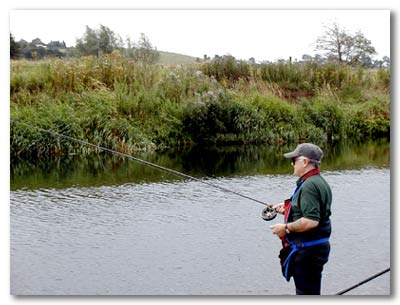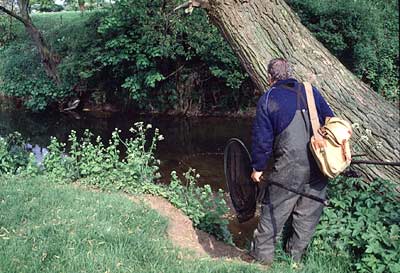A quiet approach Before I move on to the basics of trotting I think it is vital to stress the importance of the quiet approach. Riverbanks vary in geography from flat and low, typically found on the Hampshire Avon and Thames where there is hardly any cover at all, to steep and treacherous such as parts of the Bristol Avon. Thumping a box down on the bank, bashing reeds down with a bankstick, skylining and heavy footsteps, none of these will help you catch fish. There is much to be said for tackling up well away from the water’s edge then quietly getting into position.
At times, summer matches on parts of the upper Dorset Stour are not dissimilar to this where, if one is quiet enough, it is possible to get a chub in the first few minutes with the target fish usually visible. This is a flying start when weights are not likely to be especially high. In one particular match I spotted just such a fish and tackled up well away from the bank. Fifty yards downstream the next angler was busily smashing down the rushes. After tackling up I asked him whether he ever got any chub. “Oh no, never see any in this stretch,” he replied. I crept back and got my chub, all eight ounces of him. Get organised This covers the approach, but what about improving things when actually fishing. The need to constantly keep moving from the fishing position is reduced by keeping low and well organised. Keep thing things to hand with disgorger, spare hooks and shot readily available. Don’t get up each time you catch a fish unless it is to take a specimen well away from the swim to photograph. Feather the cast onto the water by gently easing your forefinger onto the line as the terminal tackle nears the end of the cast. Play fish quietly by only bringing them to the top when ready for netting and hustling them away from the shoal quickly. What is trotting? The most basic technique for floatfishing moving water is trotting. What is trotting, and why is it effective? Trotting is using a float to swim a bait downstream with the current, exploring the swim. The bait is usually near to or tripping the bottom through, not necessarily so. It is also usual to feed the swim so that the baited hook is near groundbait or loose samples of the hookbait. It all sounds very simple. If you are a beginner I would suggest you make it easy for yourself and follow these simple guidelines to start with. Pick a swim with no overhanging branches, a steady, gentle pace and a fair depth of between five and seven feet. Look for a swim with a steady current about six to ten yards out with a clear trot, and no thick weed beds or obvious snags. Ensure the wind is favourable, light and off your back. Pick a float taking about four or five BB, a small crow quill, Avon or balsa. Attach it to the line top and bottom with float-rubbers. If it’s an Avon use a third float-rubber at the base of the body. Attach the hooklength to the main line, loop to loop, and set the float to a depth of about six feet, dipping the float in the water before moving it. Dry line will melt due to heat caused by friction if moved through the float rubbers, so always ensure it is wet before moving the float, indeed I always wet the float before putting the float rubbers on for the first time. Plumbing the depth Next, you need to discover the contours of the swim. Attach a plummet to the hook. Using a gentle underhand swing cast out into the swim and tighten the line. What is the depth like compared to your guess? If your guess is close re-plumb both further out and closer in, as well as along the chosen trotting path. Adjust the float as necessary. Take your time over this. Provided the bottom is fairly clean the initial setting should be slightly over-depth. If the float keeps dragging under reduce the depth slightly. Conversely, if it doesn’t drag under at all try increasing the depth, only three inches at a time until it does, then reduce it by an inch. A simple shotting pattern to start with would be to bunch almost all of the shot two feet from the hook with a small dropper shot about ten inches from the hook. Ensure that no more than half an inch of tip is showing. The basics of feeding the swim
Learning to control the float Once the float has settled ensure that the line is straight between the rod and float. Allow the float to trot downstream. You will notice that the line will tend to bow and overtake the float, with the float drifting in towards the near bank. Try to mend the line every few yards so that it is once again straightened out behind the float. Once it reaches the end of the trot quietly retrieve and start again. Don’t forget to feed. It may take a while to start to get bites. Strike with a sharp but controlled upwards movement that just about moves the float out of the water. The first refinement – holding back The above seems very simple and has been included for beginners to rivers. Let’s start to improve the basic technique before moving on to the advanced stuff. The first refinement must be to slow the float down; ie, holding it back. The water in a river will usually be flowing more slowly near the bottom due to drag. But an unhindered float will be towing the bait along faster than those loose-fed samples of maggots. To control the speed of the float we need to control the rate at which the line is fed to the float. This is the skill that takes lots of practice but is an essential skill that applies to all river floatfishing. Judging just how much to retard the bait takes experimentation and experience. Not enough and the bait is still whizzing past the fishes’ noses, too much and the float tends to rise out of the water and drift into the near bank. There is a shortcut to learning how to control the float. Pinch a dust shot on the line about a foot above the float. This is your control marker. When you pay out line to the float this shot will try to sink the line. By increasing the retarding effect slightly it is possible to keep this shot about an inch above the water. It will take practice, and this is the reason for initial attempts at trotting to be at close range but line control is everything in trotting. Practice is the key to all of this. If you mis-cast, retrieve and recast until you are casting smoothly and accurately. Assistance from an experienced and skilled angler at this point is invaluable. Inconsistency in feeding is the most glaring fault made by beginners. Next week: more advanced techniques |
Welcome!Log into your account













